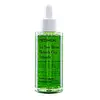What's inside
What's inside
 Key Ingredients
Key Ingredients

 Benefits
Benefits

 Concerns
Concerns

No concerns
 Ingredients Side-by-side
Ingredients Side-by-side

Water
Skin ConditioningGlycereth-26
HumectantPEG/PPG-17/6 Copolymer
SolventGlycerin
HumectantNiacinamide
SmoothingSodium Hyaluronate
Humectant1,2-Hexanediol
Skin ConditioningPolyglutamic Acid
Skin ConditioningPanthenol
Skin ConditioningTrehalose
HumectantBetaine
HumectantHydroxyethyl Urea
HumectantRosa Centifolia Flower Water
Skin ConditioningFomes Officinalis Extract
Skin ProtectingHamamelis Virginiana Water
AstringentPrunus Amygdalus Dulcis Seed Extract
Skin ConditioningGlutamine
Skin ConditioningGlutamic Acid
HumectantArginine
MaskingAlanine
MaskingPhenylalanine
MaskingProline
Skin ConditioningPortulaca Oleracea Extract
Skin ConditioningHydrolyzed Collagen
EmollientAloe Barbadensis Leaf Juice
Skin ConditioningBeta-Glucan
Skin ConditioningXanthan Gum
EmulsifyingButylene Glycol
HumectantBoswellia Serrata Resin Extract
SmoothingSalix Alba Bark Extract
AstringentCarbomer
Emulsion StabilisingAllantoin
Skin ConditioningPolysorbate 80
EmulsifyingAdenosine
Skin ConditioningDisodium EDTA
Tocopheryl Acetate
AntioxidantParfum
MaskingWater, Glycereth-26, PEG/PPG-17/6 Copolymer, Glycerin, Niacinamide, Sodium Hyaluronate, 1,2-Hexanediol, Polyglutamic Acid, Panthenol, Trehalose, Betaine, Hydroxyethyl Urea, Rosa Centifolia Flower Water, Fomes Officinalis Extract, Hamamelis Virginiana Water, Prunus Amygdalus Dulcis Seed Extract, Glutamine, Glutamic Acid, Arginine, Alanine, Phenylalanine, Proline, Portulaca Oleracea Extract, Hydrolyzed Collagen, Aloe Barbadensis Leaf Juice, Beta-Glucan, Xanthan Gum, Butylene Glycol, Boswellia Serrata Resin Extract, Salix Alba Bark Extract, Carbomer, Allantoin, Polysorbate 80, Adenosine, Disodium EDTA, Tocopheryl Acetate, Parfum
Melaleuca Alternifolia Leaf Water
AntimicrobialButylene Glycol
HumectantGlycerin
Humectant1,2-Hexanediol
Skin ConditioningDiethoxyethyl Succinate
SolventWater
Skin ConditioningCutibacterium Granulosum Ferment Extract Filtrate
EmollientCamellia Sinensis Leaf Extract
AntimicrobialMelia Azadirachta Leaf Extract
Skin ConditioningPolyglyceryl-10 Laurate
Skin ConditioningPolyglyceryl-10 Myristate
Skin ConditioningAcrylates/C10-30 Alkyl Acrylate Crosspolymer
Emulsion StabilisingArginine
MaskingMelia Azadirachta Flower Extract
Skin ConditioningEthylhexylglycerin
Skin ConditioningXylitylglucoside
HumectantSclerotium Gum
Emulsion StabilisingAnhydroxylitol
HumectantLecithin
EmollientXylitol
HumectantMaltodextrin
AbsorbentPentylene Glycol
Skin ConditioningHydrolyzed Acacia Macrostachya Seed Extract
Skin ConditioningPersea Gratissima Fruit Extract
EmollientGlucose
HumectantAsiaticoside
AntioxidantAsiatic Acid
Skin ConditioningMadecassic Acid
Skin ConditioningCentella Asiatica Extract
CleansingPolygonum Cuspidatum Root Extract
AntioxidantScutellaria Baicalensis Root Extract
AstringentSodium Hydroxide
BufferingTocopherol
AntioxidantGlycyrrhiza Glabra Root Extract
Bleaching4-Terpineol
MaskingMadecassoside
AntioxidantCaprylic/Capric Triglyceride
MaskingChamomilla Recutita Flower Extract
MaskingRosmarinus Officinalis Leaf Extract
AntimicrobialChaenomeles Sinensis Fruit Extract
AntioxidantCitrus Aurantium Dulcis Flower Extract
Skin ConditioningMelilotus Officinalis Extract
AstringentMedicago Sativa Extract
TonicTriticum Vulgare Germ Extract
Skin ConditioningBrassica Oleracea Italica Extract
AstringentBrassica Oleracea Capitata Leaf Extract
Skin ConditioningBrassica Campestris Extract
Skin ConditioningRaphanus Sativus Seed Extract
Skin ConditioningMelaleuca Alternifolia Leaf Water, Butylene Glycol, Glycerin, 1,2-Hexanediol, Diethoxyethyl Succinate, Water, Cutibacterium Granulosum Ferment Extract Filtrate, Camellia Sinensis Leaf Extract, Melia Azadirachta Leaf Extract, Polyglyceryl-10 Laurate, Polyglyceryl-10 Myristate, Acrylates/C10-30 Alkyl Acrylate Crosspolymer, Arginine, Melia Azadirachta Flower Extract, Ethylhexylglycerin, Xylitylglucoside, Sclerotium Gum, Anhydroxylitol, Lecithin, Xylitol, Maltodextrin, Pentylene Glycol, Hydrolyzed Acacia Macrostachya Seed Extract, Persea Gratissima Fruit Extract, Glucose, Asiaticoside, Asiatic Acid, Madecassic Acid, Centella Asiatica Extract, Polygonum Cuspidatum Root Extract, Scutellaria Baicalensis Root Extract, Sodium Hydroxide, Tocopherol, Glycyrrhiza Glabra Root Extract, 4-Terpineol, Madecassoside, Caprylic/Capric Triglyceride, Chamomilla Recutita Flower Extract, Rosmarinus Officinalis Leaf Extract, Chaenomeles Sinensis Fruit Extract, Citrus Aurantium Dulcis Flower Extract, Melilotus Officinalis Extract, Medicago Sativa Extract, Triticum Vulgare Germ Extract, Brassica Oleracea Italica Extract, Brassica Oleracea Capitata Leaf Extract, Brassica Campestris Extract, Raphanus Sativus Seed Extract
 Reviews
Reviews

Ingredients Explained
These ingredients are found in both products.
Ingredients higher up in an ingredient list are typically present in a larger amount.
1,2-Hexanediol is a synthetic liquid and another multi-functional powerhouse.
It is a:
- Humectant, drawing moisture into the skin
- Emollient, helping to soften skin
- Solvent, dispersing and stabilizing formulas
- Preservative booster, enhancing the antimicrobial activity of other preservatives
Arginine is an amino acid that is important for human development. Your body uses is it to produce hair keratin and skin collagen.
As a cosmetic ingredient, Arginine has antioxidant properties and can also help repair damaged skin. This ingredient is derived either synthetically or from animals.
Arginine isn't fungal acne safe when used in the presence of other lipids (fats, fatty acids, oils, esters, etc). Oils and fats occur naturally within the skin, so take caution when using Arginine if you're prone to fungal acne.
Learn more about ArginineButylene Glycol (or BG) is used within cosmetic products for a few different reasons:
Overall, Butylene Glycol is a safe and well-rounded ingredient that works well with other ingredients.
Though this ingredient works well with most skin types, some people with sensitive skin may experience a reaction such as allergic rashes, closed comedones, or itchiness.
Learn more about Butylene GlycolGlycerin is already naturally found in your skin. It helps moisturize and protect your skin.
A study from 2016 found glycerin to be more effective as a humectant than AHAs and hyaluronic acid.
As a humectant, it helps the skin stay hydrated by pulling moisture to your skin. The low molecular weight of glycerin allows it to pull moisture into the deeper layers of your skin.
Hydrated skin improves your skin barrier; Your skin barrier helps protect against irritants and bacteria.
Glycerin has also been found to have antimicrobial and antiviral properties. Due to these properties, glycerin is often used in wound and burn treatments.
In cosmetics, glycerin is usually derived from plants such as soybean or palm. However, it can also be sourced from animals, such as tallow or animal fat.
This ingredient is organic, colorless, odorless, and non-toxic.
Glycerin is the name for this ingredient in American English. British English uses Glycerol/Glycerine.
Learn more about GlycerinWater. It's the most common cosmetic ingredient of all. You'll usually see it at the top of ingredient lists, meaning that it makes up the largest part of the product.
So why is it so popular? Water most often acts as a solvent - this means that it helps dissolve other ingredients into the formulation.
You'll also recognize water as that liquid we all need to stay alive. If you see this, drink a glass of water. Stay hydrated!
Learn more about Water